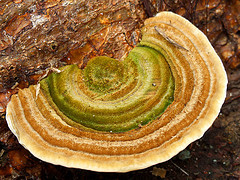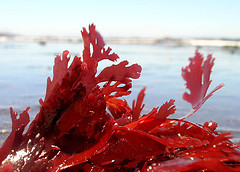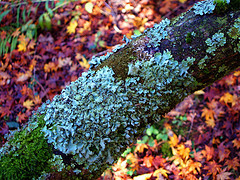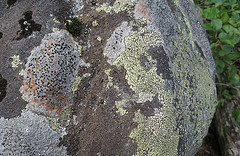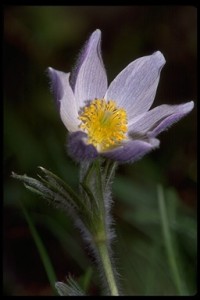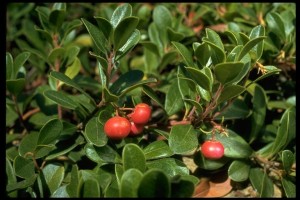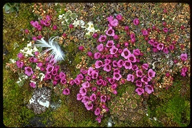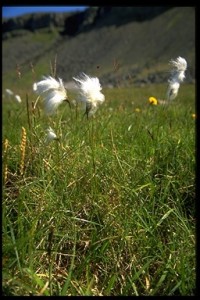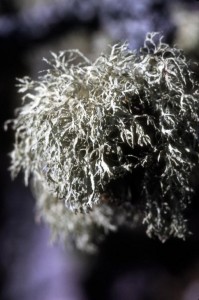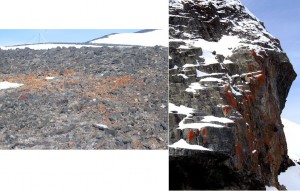Plants of the Arctic and Antarctic
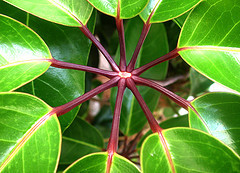 When we think of the word “plants” we typically picture trees,
bushes, grasses, and ferns – so-called “vascular plants” because of
their full systems of leaves, stems, and roots. However, the plant
kingdom also includes mosses, liverworts, and hornworts, simpler plants
that lack these water-transporting structures.
When we think of the word “plants” we typically picture trees,
bushes, grasses, and ferns – so-called “vascular plants” because of
their full systems of leaves, stems, and roots. However, the plant
kingdom also includes mosses, liverworts, and hornworts, simpler plants
that lack these water-transporting structures.
Photos courtesy of Scott Kinmartin and Andrew Fogg via Flickr.
A defining characteristic of plants is their ability to produce
energy through photosynthesis. Through this process, plants capture the
sun’s energy and use it to fuel chemical reactions that convert carbon
dioxide and water into oxygen and energy-containing carbohydrates
(sucrose, glucose, or starch).Plants may reproduce sexually by flowering and producing seeds, or through spore production. They also reproduce asexually through budding, bulb formation, and other types of vegetative reproduction.
Even though most algae and fungi are no longer classified within the plant kingdom, they are often still included in discussions of plant life. Algae include microscopic, single-celled, and multicellular photosynthetic organisms such as seaweeds and green, red, and brown algae. They lack the structures that characterize vascular and nonvascular plants and are classified in the kingdom Protista.
Fungi. Photo courtesy of DonGato, Flickr.
Lichens are a third group that, while often included in discussions of plants, is not classified in the plant kingdom. Lichens are a symbiotic association of a fungus and an alga. The fungus provides water and minerals from the growing surface, while the alga produces energy for both organisms through photosynthesis. Lichens compete with plants for sunlight, but their small size and slow growth allow them to thrive in places where plants have difficulty surviving.
- Lichens are a symbiotic association of a fungus and an alga. They are not plants. Photos courtesy of Trapac and brewbooks via Flickr.
ARCTIC PLANTS
Approximately 1,700 species of plants live on the Arctic tundra, including flowering plants, dwarf shrubs, herbs, grasses, mosses, and lichens. The tundra is characterized by permafrost, a layer of soil and partially decomposed organic matter that is frozen year-round. Only a thin layer of soil, called the active layer, thaws and refreezes each year. This makes shallow root systems a necessity and prevents larger plants such as trees from growing in the Arctic. (The cold climate and short growing season also prevent tree growth. Trees need a certain amount of days above 50 degrees F, 10 degrees C, to complete their annual growth cycle.)Tundra vegetation is characterized by small plants (typically only centimeters tall) growing close together and close to the ground. A few of the many species include:
| Arctic willow A dwarf shrub that is food for caribou, musk oxen, and arctic hares. The Inuit people call it the “tongue plant” because of the shape of its leaves. |
|
| Pasque flower. This plant ranges throughout the northwestern United States and up to northern Alaska. Its covering of fine silky hairs provides insulation. |
|
| Bearberry.This low-growing evergreen’s leathery leaves and silky hairs provide protection from the cold and wind. The plant was named bearberry because bears like to eat its red berries. | |
| Purple saxifrage.This plant grows in a low, tight clump. It is one of the earliest plants to bloom. The tiny, purple, star-shaped flowers (1 cm wide) often can be seen above the melting snow. | |
| Arctic poppy.This plant is about 10-15 cm tall, with a single flower per stem. The flower heads follow the sun, and the cup-shaped petals help absorb solar energy. | |
| Cottongrass.Named for its fluffy, white tufts, cottongrass is an important food source for migrating snow geese and caribou. |
ANTARCTIC PLANTS
There are only two native vascular plants in Antarctica: Antarctic hair grass and Antarctic pearlwort. These species are found in small clumps near the shore of the west coast of the Antarctic Peninsula, where temperatures are milder and there is more precipitation.ADAPTATIONS FOR A POLAR ENVIRONMENT
Similar adaptations help plants, algae, fungi, and lichens survive in both the Arctic and Antarctic.First, the size of plants and their structures make survival possible. Small plants and shallow root systems compensate for the thin layer of soil, and small leaves minimize the amount of water lost through the leaf surface.
Plants also grow close to the ground and to each other, a strategy that helps to resist the effects of cold weather and reduce damage caused by wind-blown snow and ice particles. Fuzzy coverings on stems, leaves, and buds and woolly seed covers provide additional protection from the wind.
Plants have also adapted to the long winters and short, intense polar summers. Many Arctic species can grow under a layer of snow, and virtually all polar plants are able to photosynthesize in extremely cold temperatures. During the short polar summer, plants use the long hours of sunlight to quickly develop and produce flowers and seeds. Flowers of some plants are cup-shaped and direct the sun’s rays toward the center of the flower. Dark-colored plants absorb more of the sun’s energy.
In addition, many species are perennials, growing and blooming during the summer, dying back in the winter, and returning the following spring from their root-stock. This allows the plants to direct less energy into seed production. Some species do not produce seeds at all, reproducing asexually through root growth.

